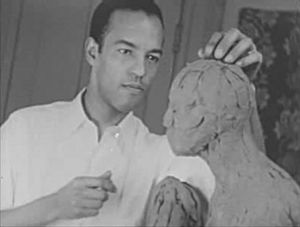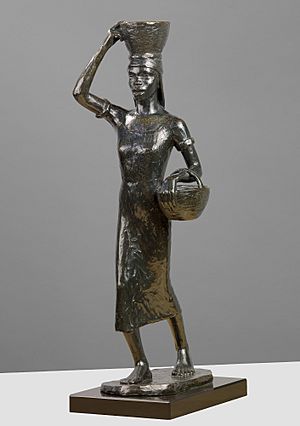Richmond Barthé facts for kids
Quick facts for kids
Richmond Barthé
|
|
|---|---|

Capture taken from the silent movie A Study of Negro Artists, filmed by Jules V.D. Bucher in 1935
|
|
| Born | January 28, 1901 |
| Died | March 5, 1989 (aged 88) |
| Nationality | American |
| Education | Art Institute of Chicago |
| Known for | Sculpture |
| Movement | Harlem Renaissance |
James Richmond Barthé, known as Richmond Barthé, was an African-American sculptor. He lived from January 28, 1901, to March 5, 1989. Barthé was part of the Harlem Renaissance, a time when Black artists, writers, and musicians created amazing works.
He was famous for sculpting Black people. His art showed the many different sides of humanity. He wanted to capture the "spiritual quality" he saw in people. He believed the human body was the best way to show this spirit.
Contents
Early Life and Artistic Beginnings
Richmond Barthé was born in Bay St. Louis, Mississippi. His father died when he was a baby. His mother, Marie Clementine Robateau, raised him alone. She worked as a dressmaker. Later, she remarried and had five more children.
Richmond loved drawing from a very young age. His mother encouraged him a lot. He once said she gave him paper and pencils to play with when he was a toddler. By age six, he was painting with watercolors.
His teachers also supported his art. His fourth-grade teacher, Inez Labat, helped him grow as an artist. When he was just twelve, his artwork was shown at the Bay St. Louis Country Fair.
Richmond faced health problems as a teenager. He got typhoid at 14 and left school. He worked as a houseboy and handyman. But he always spent his free time drawing. A rich family, the Ponds, hired him in New Orleans. This job helped him learn more about art and culture. He met Lyle Saxon, a writer who tried to get him into art school.
In 1924, Barthé gave an oil painting to a local Catholic church. It was for a fundraiser. A priest, Father Harry F. Kane, was impressed by his talent. He helped Richmond raise money to study art. At 23, with little schooling, Barthé was accepted into the Art Institute of Chicago.
Studying Art in Chicago
Richmond Barthé spent four years at the Art Institute of Chicago. He studied painting and lived with his aunt. He worked different jobs to support himself. His talent for painting portraits caught the eye of Dr. Charles Maceo Thompson. Dr. Thompson was an art supporter. He helped Richmond get many painting jobs from wealthy Black people in Chicago.
Barthé's first formal sculpture training was in anatomy class. He learned from German artist Charles Schroeder. Students used clay to understand the human body in 3D. This experience changed his path. He decided to focus on sculpture instead of painting.
Richmond Barthé showed his sculptures for the first time in 1927. It was at The Negro in Art Week exhibition. He was still a student then. He also showed his work at the Chicago Art League in 1928. Critics loved his art. He received important jobs, like making busts of famous people. These included Henry O. Tanner and Toussaint L’Ouverture. By 1929, his art education was complete. He moved to New York City to continue his career.
Success in New York City
The 1930s were very busy years for Richmond Barthé. This was even during the Great Depression, when many artists struggled. He moved to New York City after art school. He arrived during the exciting time of the Harlem Renaissance. In 1930, he opened his studio in Harlem. He later moved it to Greenwich Village in 1931. He said living downtown was better for meeting collectors. He knew it was important to connect with people who bought art.
Barthé met many artists, dancers, and actors in New York. At first, he could not afford models. So, he found inspiration from performers on stage. He had an amazing memory for visuals. This allowed him to create many sculptures of the human body in motion without models. During this time, he made famous works like Black Narcissus (1929) and The Blackberry Woman (1930). He also sculpted busts of important figures like Alain Locke.
In 1933, a large collection of Barthé's work opened the Caz Delbo Galleries. This was at the Rockefeller Center in New York City. His art was also shown at the Chicago World's Fair that same year. In 1934, he visited Paris. This trip introduced him to classical art and performers like Féral Benga. Over the next twenty years, he became a very famous sculptor. He won many awards and was seen as a leading "modern" artist. He was friends with many famous Black artists and writers. These included Langston Hughes and Claude McKay.
In 1945, Barthé became a member of the National Sculpture Society.
Later Life and Legacy
Life in New York City became difficult for Barthé. The city's busy and sometimes violent environment affected him. In 1947, he decided to leave his famous life behind. He moved to Jamaica in the West Indies. His art career continued to do well there. He stayed in Jamaica until the mid-1960s. Growing violence in Jamaica forced him to move again.
For the next five years, he lived in Switzerland, Spain, and Italy. Finally, he settled in Pasadena, California. He worked on his life story there. He also made many copies of his sculptures. The actor James Garner helped him financially with this. Garner also protected Barthé's artwork rights. He hired someone to document his work. He also created the Richmond Barthe Trust. Richmond Barthé passed away in 1989.
Notable Public Artworks
Richmond Barthé created many important public sculptures. His first big public job was for the Federal Art Project in New York City. He made an 80-foot stone relief in 1939. This artwork was installed at the Kingsborough Houses in Brooklyn.
Other famous public works include:
- A large bronze statue of Toussaint L’Ouverture (1950). It stands in front of the National Palace in Port-au-Prince, Haiti.
- A 40-foot bronze statue of Jean Jacques Dessalines (1952). This is at Champs-du-Mars in Port-au-Prince, Haiti.
- A stone relief of an American Eagle (1940). This is on the Social Security Board Building in Washington, D.C.
- The design of several Haitian coins. These coins are still used today.
Haitian Sculpture Projects
Barthé's Haitian works were some of his largest and most famous. He moved to Ocho Rios, Jamaica, in 1950. The huge 40-foot bronze statue of Jean Jacques Dessalines (1952) was one of four big sculptures. Haitian leaders ordered these in 1948 to celebrate their independence. The Dessalines monument was part of a bigger park restoration in 1954.
Barthé's 40-foot-high Toussaint L’Ouverture statue (1950) was placed near the National Palace. It was revealed in 1950. Another sculptor, Blanco Ramos, made two other heroic statues. One African-American newspaper called these statues "the Greatest Negro Monuments on earth." Barthé had sculpted L'Overture several times before. He made a bust in 1926 and a painted portrait in 1929.
Art Exhibitions
Richmond Barthé's first time showing his sculptures was in 1927. It was at The Negro in Art Week exhibition in Chicago. His first solo show was in 1930 at the Women's City Club in Chicago. He showed 38 pieces, including sculptures and paintings.
In 1932, the Whitney Museum of American Art bought his bronze Blackberry Woman (1930). This was after it was shown at their opening exhibition. In 1933, his work was shown with drawings by famous artists like Delacroix and Matisse. This was at the Caz-Delbo Gallery in New York City.
In 1942, he had an exhibition of 20 artworks in Chicago. A special exhibition called Richmond Barthé: The Seeker opened the African American Galleries. This was at the Ohr-O'Keefe Museum Of Art in Mississippi. His most recent exhibition was Richmond Barthé: His Life in Art in 2009. It showed over 30 sculptures and photos. This traveling exhibition visited several museums.
Art Collections
Many museums and galleries own Richmond Barthé's art. The Whitney Museum of American Art bought his Blackberry Woman in 1932. They also bought The African Dancer (1933) and The Comedian (1935). The Metropolitan Museum of Art bought The Boxer (1942).
Other places that have his sculptures include:
- The Smithsonian American Art Museum
- The Art Institute of Chicago
- Fallingwater (a famous house designed by Frank Lloyd Wright)
Awards and Recognition
Richmond Barthé received many honors during his life. He won the Rosenwald Fellowship in 1930. He also got the Guggenheim Fellowship in 1940.
He was one of the first African American artists to have work in the Metropolitan Museum of Art's permanent collection. This was a big achievement. In 1945, he was chosen to be part of the American Academy of Arts and Letters. He also received awards for promoting fairness between different races. He got honorary degrees from Xavier University and St. Francis University. In 1950, he won the Audubon Artists Gold Medal.
After he moved to Pasadena, California, the city honored him. They renamed the street where he lived "Barthé Drive." In 1980, U.S. President Jimmy Carter also gave him an award.
Religious Beliefs
Richmond Barthé was a dedicated Catholic. Many of his later sculptures showed religious themes. These included John the Baptist (1942) and Come Unto Me (1945). He also created Head of Jesus (1949) and Resurrection (1969). His works like The Mother (1935) and Mary (1945) showed his interest in racial justice. He received an award for this from the Catholic Interracial Council in 1945.
See also
 In Spanish: Richmond Barthé para niños
In Spanish: Richmond Barthé para niños



